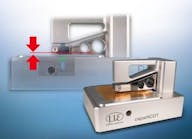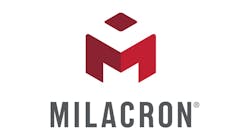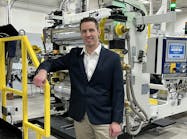Interest grows in extruders designed for recycled plastics and bioplastics
Concern for the environment is fueling interest in the U.S. for plastics recycling and the use of sustainable plastics and bioplastics. OEMs are reporting increased interest in extruders designed especially for recycling. The machines must overcome challenges particular to recycling: contamination, degassing, moisture and corrosion.
“We definitely see an increasing demand for recycled plastics, as well as sustainable plastic,” Battenfeld-Cincinnati CTO Henning Stieglitz said. “Our customers are forced by their customers to use higher amounts of recycled materials or they are asked for alternative materials. It is expected that this development will continue during the next years due to the fact that new environmental protection regulations will come into force.”
Adam Dreiblatt, director of process technology for CPM Extrusion, said many companies are looking for ways to reduce raw material costs and are increasing their use of recycled plastics as part of their sustainability efforts. The auto industry, for example, increasingly is using recycled and recyclable materials.
Dreiblatt said he believes there may be a small increase in interest in bioplastics, like polylactic acid (PLA), because manufacturers can market their products as biodegradable. In some instances, PLA can produce superior properties, such as when it replaces PS in products such as candy wrappers, he said.
Trending up
Interest in recycled plastics and bioplastics — biodegradable plastics derived from biological substances rather than from petroleum — tends to be cyclical, said Dean Elliott, a technical process manager for Entek.
Entek runs pilot plant trials for customers. Early last year, about 13 percent of its trials focused on bioplastics and/or recycled materials. However, by the end of last year, the number of trials involving those materials dropped to zero. Then, in the second quarter of this year, the percentage of bioploastic and recycled plastic trials surged to 80 percent.
“That’s what I’ve seen for the last 10 to 15 years; it comes and goes,” Elliott said.
On the sales side, Entek is seeing a significant increase in sales of extruders designed for recycling and biopolymer use, said Linda Campbell, Entek’s VP of sales.
“That’s certainly what we have seen in 2019 and 2020,” Campbell said. “The majority of our sales increase — we’ve doubled our budget in sales — is directly related to a recycled product.”
Though it doesn’t offer machinery specifically for recycling, Milacron also reported a trend toward greater sustainability over the years.
“Milacron has experienced this shift in the industry more so in the last five to six years in the manufacturing sectors we equip and service,” said Kurt Waldhauer, VP of extrusion sales for the company, which makes specialty screw designs to accommodate unique material streams. The company helps processors adapt as new resin recipes hit the market.
Built to recycle
Processors that handle bioplastics and recycled plastics have special needs that require customization, officials at a variety of OEMs said.
Some of the issues involved with recycling are material variability and moisture. But Monika Gneuss, VP of sales and marketing manager of Gneuss, said the biggest challenge is contamination.
“Depending on the material, devolatilization is very important (e.g. PET),” she said. “The filtration equipment/screen changer (to capture solid contamination particles) is another key piece of equipment.”
The company’s MRS extruder was developed specifically for recycling applications involving PET but can be used for other materials, too.
While companies engaged in closed-loop recycling usually don’t need to worry about consistency of their raw materials, it can be a significant challenge for companies that buy recycled plastics from various sources.
“There can be tremendous lot-to-lot variation in melt flow, contamination and moisture vs. virgin resin,” Dreiblatt said. “This doesn’t affect the machine hardware itself, but requires different operating conditions such as screw speed, temperature settings, etc. each time to produce the same properties. This makes it especially challenging for the production staff.”
One way to improve consistency is if processors of recycled plastics combine material from numerous lots prior to processing. That requires significant floor space to store resin and large blenders to combine it.
Depending on the level of contamination, specialized screen changers with large surface areas designed for recycling are sometimes necessary.
“The choices of different types of screen changers are quite extensive,” Elliott said. “It depends on the amount of contamination in the recycle stream.”
To deal with moisture and volatiles in the melt, compounding extruders used for recycled plastic need additional venting and possibly the use of vent stuffers, which keep the polymer in the extruder but allow the gases to escape.
“You won’t typically see that on a petroleum-based machine, but you will see it on a biopolymer machine or a recycle machine,” Elliott said.
“For petroleum-based plastics that you compound with various additives, it’s very typical to see one vent on a co-rotating, twin-screw extruder,” Elliott said. “For biopolymers and recycled polymers, it’s very common to see two or three vents on the extruder.”
Co-rotating, twin-screw extruders offer the flexibility to add venting, Campbell said.
“The twin-screw extruder equipment is looked at as more flexible than a single-screw because we have segmented barrels and screws for flexibility as to where a single screw is one solid barrel and screw,” Campbell said. “We feel like we’re uniquely positioned with our equipment to help those folks out there trying to find ways to recycle material and bring polymers to market.”
Additional concerns at play with PLA
Bioplastics come with their own unique set of concerns.
“What do biopolymers and recycled plastic have in common? What they have in common is moisture — moisture is a concern,” Elliott said. “The other thing they have in common is process variation.”
Elliott and other extrusion experts said bioplastics are more temperature-sensitive than other plastics, and they also can cause corrosion.
When processing recycled plastics (especially PET) and biopolymers, processors are likely to encounter high levels and varying levels of moisture. To deal with that, processors may need to perform pre-drying and/or use multiple vents on an extruder.
For example, starch-based biopolymers, such as those made with corn or potato starch, may contain up to 12 percent moisture, Elliott said. Cellulose-based fillers, such as those made from wood flour, have about an 8 percent moisture content. Polyhydroxyalkanoates and PLA also tend to be hygroscopic, he said.
Dealing with moisture inherent in bioplastics and recycled plastics means additional venting is recommended on co-rotating, twin-screw extruders, he said.
Because bioplastics tend to be temperature-sensitive, extruders that are dedicated to processing those materials need to have barrel and screw designs that minimize shear. While virgin and recycled petroleum-based polymers can withstand considerable shear heat, bioplastics cannot.
“You have to treat them more gently,” Elliott said. “You can’t be too aggressive with them in processing.”
That means barrels sometimes need to be shorter. In addition, if a fiber like hemp is added to a bioplastic, it must be fed into melt further down the barrel. Otherwise, it would likely burn during processing.
“You would melt the polymer first, and then you add the hemp downstream,” Elliott said.
Processors that handle bioplastics not only must consider how their machines treat the materials; they should also consider how the bioplastics are treating their machines.
Michael Duff is the VP for sales and service at Graham Engineering, which sells single-screw extruders under the American Kuhne and Welex brands, as well as a co-rotating conical twin-screw extruder known as the Welex Converge CTS.
One recent trend among Graham Engineering customers is that they are ramping up use of extruders that previously processed bioplastics only on a part-time basis, Duff said. Now, some are dedicating some of their production equipment on a full-time basis to bioplastics production.
“The challenges of running PLA or the opportunities to run PLA may be different when you’re running it full-time vs. cycling in and out with other polymers,” Duff said.
Corrosion is a concern, especially when a line is down and the material is sitting inside.
“We want to make sure that the metallurgies that we use are compatible with that and don’t lead to any destructive or corrosive situations that then turn into machinery damage and safety hazards,” he said. “That’s probably the biggest overarching concern, and we know how to do that and do it well.”
Several special metals can be used inside an extruder for parts that come in contact with PLA melt, Duff said. The company works with the bioplastic producer to select appropriate metals, he said.
Because recycled plastics vary in size, form and bulk, the correct choice of feeding, extrusion and conveying technology is important in ensuring optimal product quality, Coperion said in an emailed response to Plastics Machinery Magazine. Designing equipment for processing bioplastics, also involves customization.
“Due to the variety of potential base polymers and the diversity of recipe mixtures, every process step in the processing system needs to be individually tailored to the desired mechanical properties of the biomaterial,” the company said.
Bruce Geiselman, senior staff reporter
Contact:
Battenfeld-Cincinnati USA, McPherson, Kan., 620-241-6843, www.battenfeld-cincinnati.com
Coperion Corp., Sewell, N.J., 856-256-3175, www.coperion.com
CPM Extrusion Group, Traverse City, Mich., 231-947-6400, www.cpmextrusiongroup.com
Entek Manufacturing, Lebanon, Ore., 541-259-1068, http://entek.com/
Gneuss Inc., Matthews, N.C., 704-841-7251, www.gneuss.com
Graham Engineering Corp., York, Pa., 717-848-3755, www.grahamengineering.com/
Milacron LLC, Batavia, Ohio, 513-536-2000, www.milacron.com
Bruce Geiselman | Senior Staff Reporter
Senior Staff Reporter Bruce Geiselman covers extrusion, blow molding, additive manufacturing, automation and end markets including automotive and packaging. He also writes features, including In Other Words and Problem Solved, for Plastics Machinery & Manufacturing, Plastics Recycling and The Journal of Blow Molding. He has extensive experience in daily and magazine journalism.
Guill Tool hires new sales representative
PTi names Ryan Pasturczak sales manager






